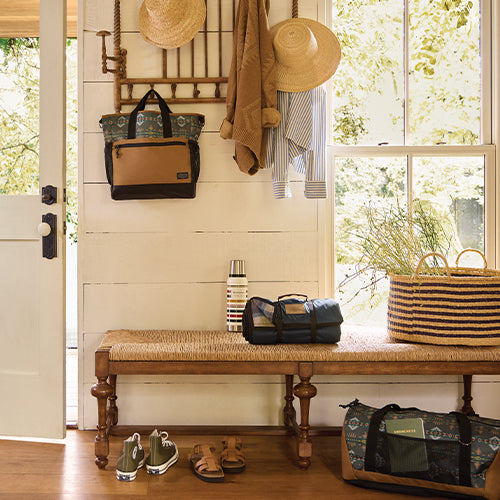Pendleton® Wool Sourcing
Pendleton supports the humane and ethical treatment of animals and endorses the American Sheep Industry (ASI) in their efforts to promote sheep welfare practices in wool production through education on nutrition, environment, behaviour, health, and handling. While Pendleton sources wool the world over, including the United States, all of our wool growers are held to the same standards of treatment, regardless of country of origin.
We encourage our long-standing wool growers and industry partners to adopt the best management practices possible and maintain healthy flocks to ensure a sustainable supply of quality wool fibre.
What is jacquard fabric?
Fabrics made on special looms or knitting machines that create intricate designs are called jacquards. Fabrics range from lightweight worsteds to heavier woolen blanket cloth. An added benefit to jacquard fabrics is that they are reversible, with the inverted colours on the opposite side.
What is the difference between worsted and woolen wool fabrics?
Wool yarns are used to create a wide variety of wool fabrics–from flannel shirting, soft knits, and fuzzy melton cloth to smooth-surfaced worsted suitings and classic gabardines. The type of wool yarn used– woolen or worsted–often distinguishes the fabric’s ultimate appearance, performance and care. The broad assortment of wool fabrics provided by woolen and worsted technologies make it possible to select wool garments that span the seasons and life’s many activities in comfort.
Worsted wool fabrics are made from finer wool fibres–generally 3” to 5” long. Additional combing and a tighter yarn twist ensures a smooth, relatively fuzz-free yarn. The resulting worsted yarns are woven into wool fabrics that are crisp and smooth-surfaced and generally lighter in weight than woolens. That makes them perfect for spring and summer wear in particular. Examples include gabardine, lightweight wool suiting, and wool challis. Long-wearing, worsted wool fabrics hold a crease well and retain shape.
Woolen fabrics are made from yarns spun from wool fibres that vary in length from 1” to 3”. After carding the raw wool– untangling and combing it to line up the short, fuzzy fibres–it is spun into yarns with low or medium twist. The resulting yarns and the fabrics woven from them have a soft, textured hand. They may also look and feel fuzzy and warm. Easy-to-tailor woolens are available in a range of fabrics from soft knits to flannels, tweeds, and coating fabrics.
What is the difference between napped and unnapped wool fabrics?
The term napped or unnapped is used on our blankets to describe the look and feel of the wool. It has to do with one of the many finishing processes of our fabric production. Once the fabric has been woven, the wool fibres can either be combed upright (napped), or left as-is to lay flat (unnapped). While the weights of napped or unnapped blankets are similar, napped blankets are often twice as thick from the fibres being upright. The flat fibres in an unnapped blanket allow for crisper lines in the design, and make it a little easier to spot clean. Either way, you’ll have a quality blanket that will last a lifetime.
How do I care for my Pendleton® wool?
With the proper care, wool garments and hats will provide years of wearing comfort. Take good care of your wool blankets and they could end up cherished heirlooms to pass on to future generations. Here are some care tips for your wools.
- Unless soiled, most wool garments and blankets require cleaning only once or twice a year. Examine periodically for hidden stains.
- Always follow the cleaning instructions provided on the garment care label.
- Allow at least 24 hours between wearings. Wool’s natural resiliency helps shed the wearing wrinkles and returns garments to their original shape.
- Remove surface soil and revive surface nap by brushing wool garments lengthwise with a garment brush. It is particularly important to brush garments made with heavily napped surfaces on a regular basis. Revive finer wool fabrics with a damp sponge instead.
- Do not press over stains. The heat can set the stain. Spot clean, dry clean or launder first.
- When traveling, cover wool garments on hangers with plastic dry cleaners’ bags to help avoid unnecessary wrinkling. On arrival, remove the bags and refresh the garments quickly by hanging in a steamy bathroom.
- Store garments in a closet with plenty of air and plenty of space so they can breathe. Zip zippers and fasten the top button to avoid unnecessary wrinkles.
- To retain garment shape, use shaped coat and suit hangers for tailored jackets and shirts; use padded hangers for blouses and dresses.
- To preserve shoulder shape and prevent unnecessary stretching, fold sweaters carefully and store in drawers or on a closet shelf. Alternatively, fold and hang over a padded or tubular hanger bar.
- If you’re caught in the rain, hang damp wool clothing out of direct heat and sunlight to dry. Brush when dry.
Cleaning Wool
Dry Clean or Wash?
Wool cleaning options include dry cleaning, hand washing, or machine washing. If the label says “Dry Clean Only,” take the garment to a professional dry cleaner for the very best results. To avoid shrinkage and damage to the hand of the fabric, do not machine wash! A tailored garment with shoulder pads and lining should only be dry cleaned in order to preserve the inner construction and shaping for longer, more attractive wear. Many linings are not washable as well. And, when having your fine wool garments dry cleaned, always be sure to check around for a reputable dry cleaner.
Hand Washing Wool
If the care label says “hand wash”, handle garments carefully. Hot water and too much agitation will cause irreversible shrinkage. Follow these guidelines for best results:
- Before washing knits, take garment length and width measurements at several places, including the shoulders, chest, sleeves and hem edges, so that you can resize it when damp.
- Use a mild detergent in enough lukewarm water to cover the garment completely. NO BLEACH svp.
- Immerse the garment and allow to soak for 3 to 5 minutes. Squeeze gently to force water and suds through the garment. DO NOT WRING, TWIST, OR SCRUB.
- Rinse thoroughly, using two or more rinses of clear, cool water to remove all trace of soap.
- Squeeze gently to remove excess water before lifting from the sink.
- Arrange the garment between two terry cloth towels and roll. Allow to rest a few minutes to absorb remaining water.
- Lay the garment flat, reshaping as needed and allow to dry away from direct heat and sunlight. Turn the garment over when the top is dry so the remaining side can dry. DO NOT HANG to dry; wet wool stretches easily from the weight of the remaining moisture in the fibres.
- Lightly press if needed, using a steam iron and a wool press cloth.
Machine Washable Wool
Washable wool makes life easier than ever and is a wardrobe option for some often-worn garments such as sweaters and shirts. Washable wool fabrics receive a resin finish which allows them to be safely machine washed in place of the usual hand washing or dry cleaning.
The convenience of caring for these garments is a natural choice with the demands of today’s busy lifestyles. Be sure to check the label for this option to save time and cleaning costs.
Pressing & Steaming
Like other wardrobe favourites, wool garments occasionally require touch-up pressing to remove wrinkles and refresh the surface. A good iron with plenty of steam is essential.
- Make sure the ironing board cover is clean and firmly padded.
- Add water to your iron, but don’t overfill it. Set for WOOL in the STEAM range. To avoid water spotting and potential surface damage, allow iron to heat thoroughly. If water does drip and spots your wool garment, take it to the dry cleaner for steaming to remove water spotting.
- Press as much as possible on the inside of the garment to avoid surface shine and a worn look. For top pressing, use a press cloth. Special wool-fabric press cloths are available in notions departments of most fabric stores. Or, substitute a soft, white men’s handkerchief or other lightweight cotton cloth.
- When pressing lightweight worsted suits, avoid using a steamer. Use a steam iron and a press cloth instead. Apply pressure with the iron for a smoother surface and crisp edges. For a really professional look, tuck white paper strips under the seam edges to avoid seam imprints. Steamers are great for easing wearing wrinkles out of woolen fabrics with more texture and surface interest.
What about Scorch and Press Shine?
The best defence is a careful hand with the iron to avoid heat damage to the surface of your fabric. Always use steam heat, not dry. But if scorch or shine should happen, the following treatments might help.
Scorch. If the fabric is napped and only lightly scorched, rub very lightly with an emery board to lightly scrape away the scorched fibre ends. For heavier scorch, apply a diluted solution of hydrogen peroxide (test first on a hidden seam). Flush thoroughly with cool water and air dry.
Shine. Sponge with white vinegar and rinse thoroughly with cool water.
Stain Removal
Although wool is naturally soil repellent, accidents do happen. Quick action is the best defence. It’s easier to remove most food and beverage stains while they are still fresh.
- Treat stains promptly to prevent setting. Blot, don’t rub, using a clean white tissue or soft cloth to remove as much as possible.
- Take garments with stubborn stains to the dry cleaner as soon as possible–within a day or two is best. Be sure to identify the source of the stain and point out the location.
- Avoid pressing stained or soiled garments. Iron heat can make stains permanent or difficult to remove.
- Chemical stains–dyes, ink, nail polish, paint, correction fluid, paint, and shoe polish–are the most difficult to remove and the most damaging. Take these to the dry cleaner.
Keep a bottle of stain-removal solution on hand for emergencies but make sure it is safe for use on wool. Chocolate, cosmetics, and oily based stains respond best. Do not use hot water on any of these stains as it may set them or cause the dyes to spread. Follow the package directions and the following precautions:
- First, test the solution on a seam allowance or other inconspicuous place to make sure the dye is colourfast.
- Place the right side of the garment against an absorbent paper towel or cloth.
- To keep the stain from spreading, work from the outer edges toward the centre of the stain. To prevent surface damage to the fabric, avoid rubbing. Instead, dab or blot the area with an up and down motion. DO NOT RUB.
Wool Storage Tips
Wool is much loved by several species of moths and carpet beetles, who find it a tasty meal. An ounce of prevention goes a long way toward protecting your wool items from these uninvited guests. The clothes moth–a harmless looking little buff-coloured critter with fringed wings–is the most common wool pest. It loves the dark interior of your closet where it lays its eggs. The hatching larvae – tiny white worms that hide in the fabric–are the real culprits who chew their way through your favourite slacks or jacket with great gusto, leaving unsightly holes behind. Since the larval stage can last from a few weeks to over a year, the potential for damage to your favourite clothes is ongoing. Wearing and brushing your wool clothing is one defence. Taking a few preventive measures will ensure that you don’t provide an off-season dining spot for these unwanted pests.
- Clean everything before storing your wool clothing for extended periods. If you are storing other out-of-season clothes with your wools, make sure they are clean too. Food stains and invisible body oils attract moths. They might not munch on your unlaundered acrylic shirt, but they’re sure to find your very best wool jacket hanging right alongside it. Dry cleaning will kill and remove any moth eggs and larvae. Laundering (if appropriate) also removes them from wools.
- Store clean clothing and blankets in airtight bags or containers. Fold lightweight, delicate, or stretchy knits, adding tissue paper between folds to prevent creases.
- For added protection, use mothballs or moth crystals as directed on the package. Don’t put them directly on the wool; suspend them in small, loosely woven cloth bags above the garments. After storage, air clothing outside to remove any residual mothball odour.
- To help retain shape, tuck tissue paper inside wool hats and store in a hat box.
- If you find signs of insect damage, clean garments hanging near by to remove remaining eggs and larvae; be sure to vacuum the closet. Check garments periodically to make sure you are rid of the larvae and brush clothes regularly during the wearing season.
- Cedar Alert. Contrary to popular belief, the best defence against moths and other wool-eating insects is not cedar. Cedar oil in closets and chests may repel moths, but only when the odour is strong. It won’t stop them dead in their tracks. That goes for herbal sachets and other products that rely on a fragrance to repel insects.



